Putting together a charter for a company takes quite a bit of work. You may be thinking, “Well, I know exactly what my business is all about, so why bother?”
You’re right, of course. But the bigger question is, do your employees know exactly what your business is all about? What are your overarching goals? What principles and values do you want your employees to uphold while they work for you?
Consider creating an organizational charter and derivative team charters to align everyone to your vision for the company.
The examples of organizational charters outlined in this article and our 10-step guide for creating a charter will help get you started.
What is an organizational charter, and how does it differ from a team charter?
An organizational charter, often referred to as a “charter” for short, is a formal document that outlines an organization’s purpose, mission, values, goals, and structure.
It serves as a foundational framework that defines the organization’s core principles and objectives and paints a concise picture of how it operates.
A charter typically outlines the roles and responsibilities of the company’s key stakeholders, including managers and team leaders, employees, and sometimes, external partners.
It may also include information about the organization’s history, legal status, governance structure, and any specific policies or guidelines that guide its activities.
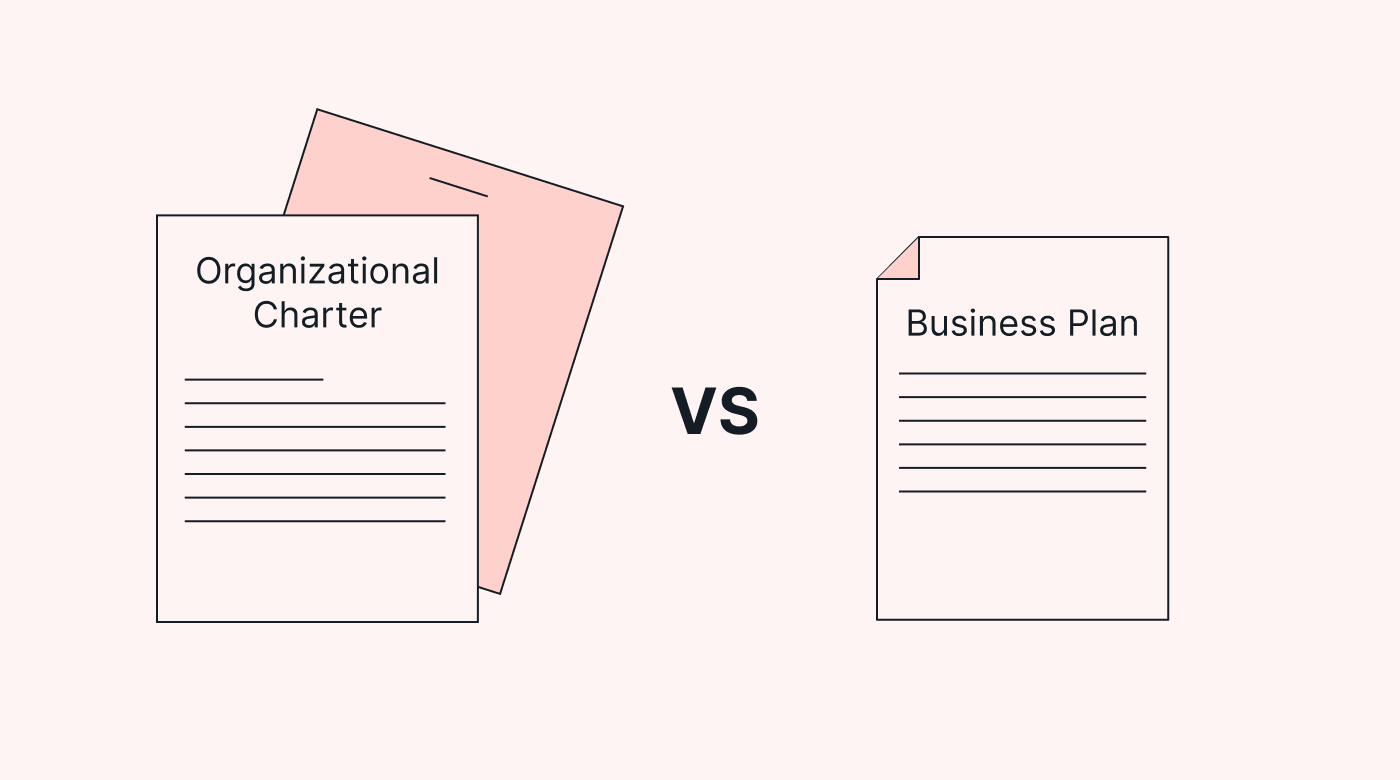 |
A charter is not a business plan. Business plans typically include short-term goals and projects, action plans, timelines, and budget calculations. A business plan functions within the broader guidelines the organizational charter sets.
Why create an organizational charter?
An organizational charter helps establish a clear direction for businesses, nonprofit organizations, government agencies, and other groups. It provides a basis for decision-making and accountability.
A charter is designed to communicate the organization’s purpose, vision, and operational guidelines to its members and external and internal stakeholders. The goal is organization-wide alignment and effective functioning.
What is a team charter?
A team charter is a stepped-down slice of an organizational charter that specifies the role of each team or even each employee. Teams themselves develop these charters within the context of the overarching organizational charter.
We’ll discuss organizational charters first before transitioning to team charters.
Examples of organizational charters
Let’s look at two different examples of organizational charters for small businesses. For each of them, we’ll include the mission, vision, core values, business goals, organizational structure and responsibilities, and any special commitments that set the company apart from its competitors.
Example 1: Construction company
The first example is one for an imaginary construction company, Hometown Builders. They have 25 employees and are located in a small town in a rural region. They build homes, sheds, and barns, and they also do renovations. They value neighborliness and quality craftsmanship, and they often go the extra mile.
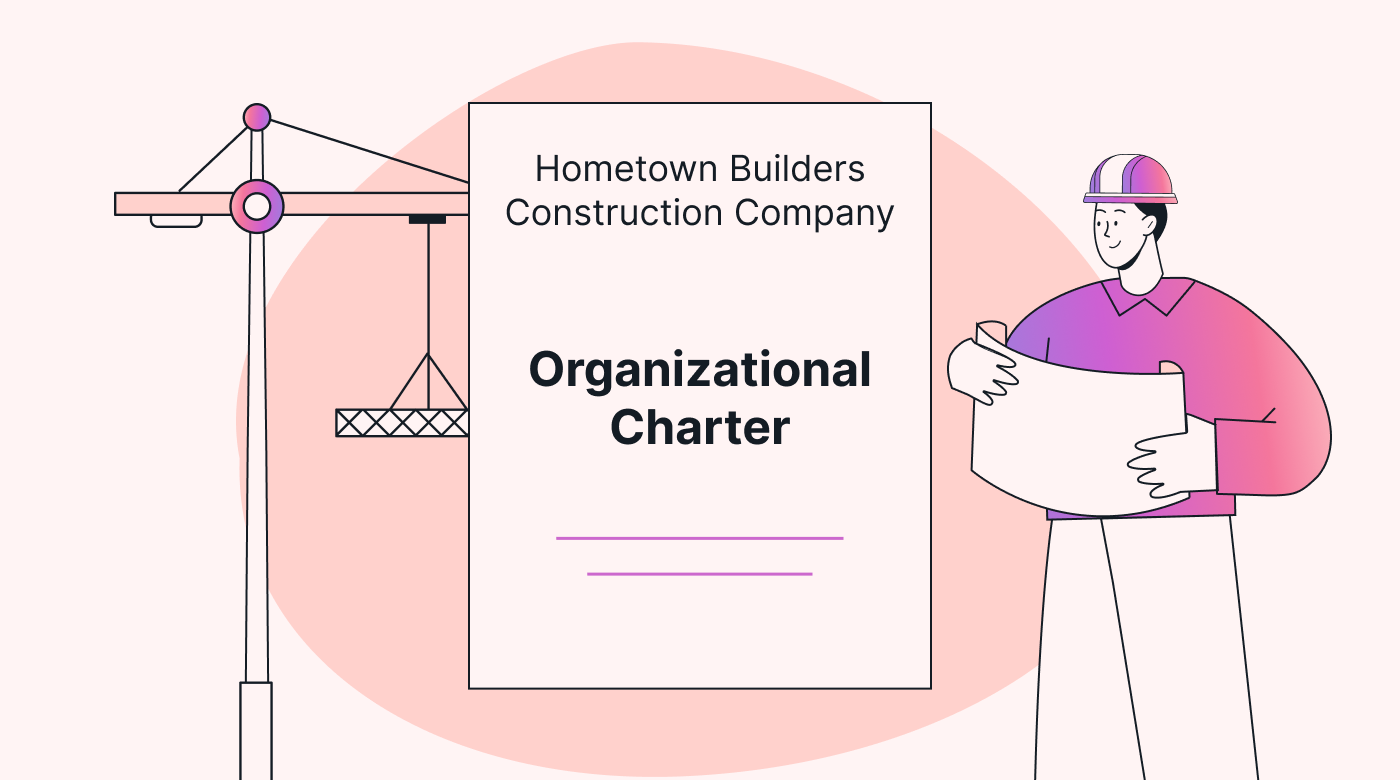 |
Hometown Builders Construction Company
Organizational Charter
Mission
Hometown Builders is committed to crafting quality homes and structures that stand as testaments to our values of neighborliness, exceptional craftsmanship, and giving back to the community. Through our work and dedication, we transform spaces and improve lives.
Vision
We envision a region where our work not only enriches the physical landscape but also strengthens the relationships within our community.
Core values
- Neighborliness: We embody the spirit of a tight-knit community by treating clients, partners, and colleagues as neighbors and friends.
- Craftsmanship excellence: We take immense pride in delivering exceptional quality in every project, reflecting our commitment to the artistry and skill of our trade.
- Going the extra mile: We consistently exceed expectations. We go above and beyond to make sure our clients are satisfied.
- Giving back: We believe in the importance of giving back to the community that supports us. We dedicate time and resources to volunteer projects that uplift the less privileged in our region.
Business goals
- To consistently deliver construction projects of the highest possible quality, showcasing our dedication to precision and superior workmanship.
- To contribute to the growth and vitality of our town by constructing homes, structures, and renovations that elevate the aesthetic and practical aspects of our community.
- To build strong, lasting relationships with clients, partners, and employees that extend beyond business transactions.
- To actively participate in our monthly volunteer initiatives, using our skills and resources to positively impact the lives of those less fortunate.
Organizational structure
- Owner and Founder: Sets the company’s direction and values, oversees strategic initiatives, and identifies volunteer opportunities.
- Operations Manager: Oversees project management and scheduling and is responsible for efficient construction operations.
- Project Managers: Lead and manage construction projects and crews. Are responsible for projects’ quality, safety, and timely completion.
- Customer Relations Specialist: Engages with clients, ensuring their needs are met and providing excellent service.
- Finance and Administration Manager: Manages the business’s financial aspects, administration, resource allocation, and volunteer projects.
Commitment to giving back
At Hometown Builders, we believe that our work extends beyond construction. Our commitment to giving back through volunteer initiatives aligns with our core values of neighborliness and making a difference in our community.
This charter reflects our dedication to our town, our clients, and the community at large. It guides our actions and decisions as we practice our trade and engage in compassionate volunteer efforts.
Date of Establishment: [Insert Date]
Location: [Insert Address]
Authorized By: [Owner/Founder Name]
Example 2: Marketing company
The next example is for an imaginary marketing company, DataMinds Marketing, which has 50 employees. The company offers marketing analytics that help small businesses and nonprofit organizations design well-informed, data-driven marketing campaigns. They value customized solutions and personal relationships with their clients.
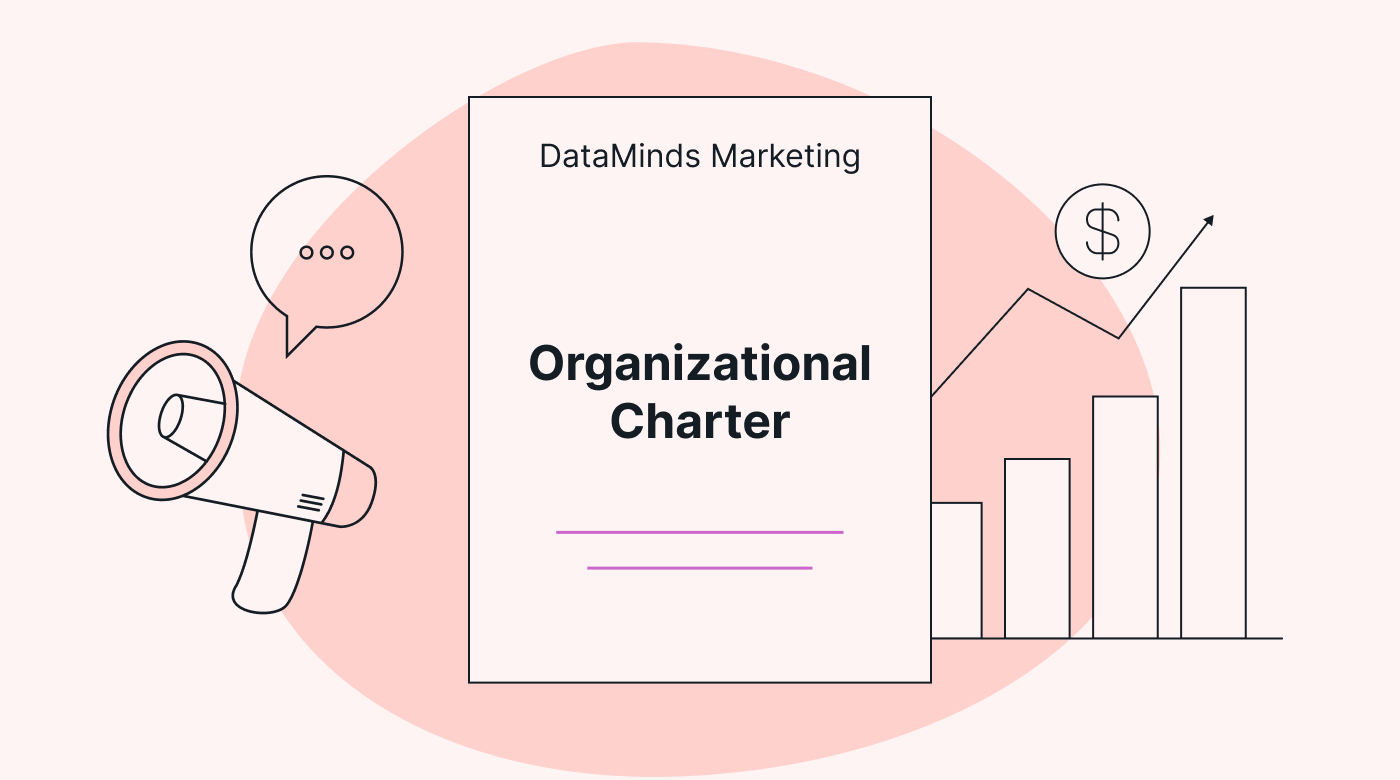 |
DataMinds Marketing
Organizational Charter
Mission statement
At DataMinds Marketing, our mission is to empower small businesses and nonprofit organizations with cutting-edge, cloud-based marketing analytics solutions. We believe in providing personalized insights that enable our clients to create data-informed marketing campaigns that generate impact and growth.
Vision
Every small business and nonprofit organization that contracts with us will be able to harness the power of data to establish meaningful connections and achieve their marketing goals.
Core values
- We are dedicated to tailoring our analytics solutions to the unique needs of each client so that they receive the most relevant insights for their marketing strategies.
- We treat our clients as extended family. We cultivate strong relationships with them based on trust, collaboration, and open communication.
- We continuously push the boundaries of technology to deliver cutting-edge analytics tools that help our clients stay ahead in a competitive landscape.
- We uphold the highest standards of data privacy and security to ensure that our clients’ information is safeguarded and used responsibly.
- We are committed to empowering our clients with knowledge and insights to enable them to make informed decisions and achieve their marketing objectives.
Goals
- To help every client achieve their marketing goals by providing actionable insights and exceptional customer support.
- To be at the forefront of marketing analytics technology, consistently delivering solutions that meet our clients’ evolving needs.
- To cultivate lasting relationships with our clients based on trust, open communication, and a deep understanding of their unique challenges and objectives.
- To foster a culture of ongoing learning and development among our employees, ensuring that they remain experts in their fields.
- To maintain the highest standards of data privacy and security.
Organizational structure
- CEO and Founder: Provides strategic direction, oversees company operations, and drives innovation.
- Chief Financial Officer (CFO): Manages and directs the company’s finances.
- Chief Technology Officer (CTO): Leads technology development, product strategy, and innovation initiatives.
- Marketing Director: Develops and executes marketing strategies to promote our analytics solutions and engage with clients.
- Client Success Manager: Ensures client satisfaction, manages relationships, and provides support for client needs.
- Product Development Manager: Manages the development of new features, enhancements, and updates to our analytics platform.
- Data Security Officer: Ensures data privacy and security compliance and manages cybersecurity measures.
- Human Resources Manager: Oversees recruitment, employee development, and organizational culture initiatives.
Commitment to customized solutions and personal relationships
At DataMinds, we are committed to providing solutions that are as unique as each of our clients. We understand that one size does not fit all, so our analytics tools are tailored to address specific challenges and opportunities. We also pride ourselves in treating our clients like family and building relationships rooted in trust, respect, and genuine care.
This charter guides our company’s mission, values, and strategic initiatives. It reflects our dedication to delivering exceptional analytics solutions and creating meaningful connections with our clients.
Date of Establishment: [Insert Date]
Location: [Insert Address]
Authorized By: [Owner/Founder Name]
How to create an organizational charter
Now that you’ve seen how these charters work, here are 10 steps to crafting an effective, inspiring charter for your own business:
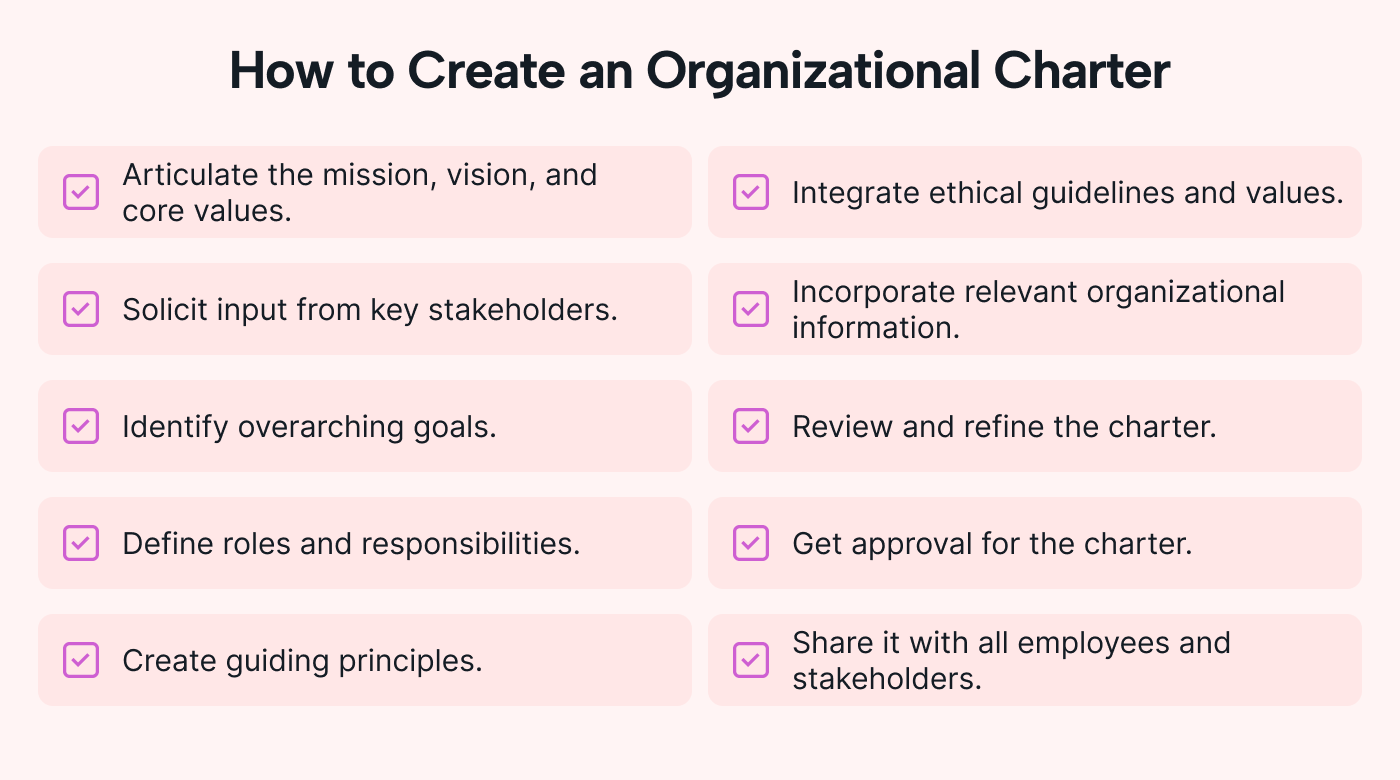 |
- Clearly articulate the organization’s mission, vision, and core values. These things serve as the guiding principles that will shape the organization’s identity and actions.
- Engage key stakeholders, including leadership, employees, and partners, in the charter’s development. Their insights and perspectives will contribute to a comprehensive document.
- Identify specific overarching goals that align with the organization’s mission. These goals will provide direction and help measure progress over time.
- Define the roles and responsibilities of the leaders and/or entire teams within the organization. You could add reporting lines and a hierarchical org chart.
- Create a set of guiding principles that reflect the organization’s culture and desired behaviors. These principles will influence decision-making and interactions.
- Integrate ethical guidelines and values that reflect the organization’s commitment to specific standards of conduct and social responsibility.
- Incorporate information about the organization’s history, legal documents on the company’s status, and any relevant policies or guidelines that govern its activities.
- Collaboratively review and refine the charter for accuracy, clarity, and alignment with the organization’s goals. Revise as needed based on the feedback you receive.
- Present the charter to leadership or relevant decision-makers for approval. Their endorsement signifies the organization’s commitment to the document.
- Share the charter with all stakeholders, employees, and partners.
A well-crafted organizational charter provides a shared understanding of the organization’s purpose and direction — but you can’t leave it on the shelf once it’s done.
Regularly refer to it to guide your team’s decision-making, actions, and interactions. And don’t forget to share it with new employees as the company’s guiding document.
Example of a team charter
Once you’ve created your organizational charter, it’s a good idea to also develop team charters to set each team’s direction and align it with the overarching vision.
Here’s what a charter for the Product Development Team at DataMinds could look like:
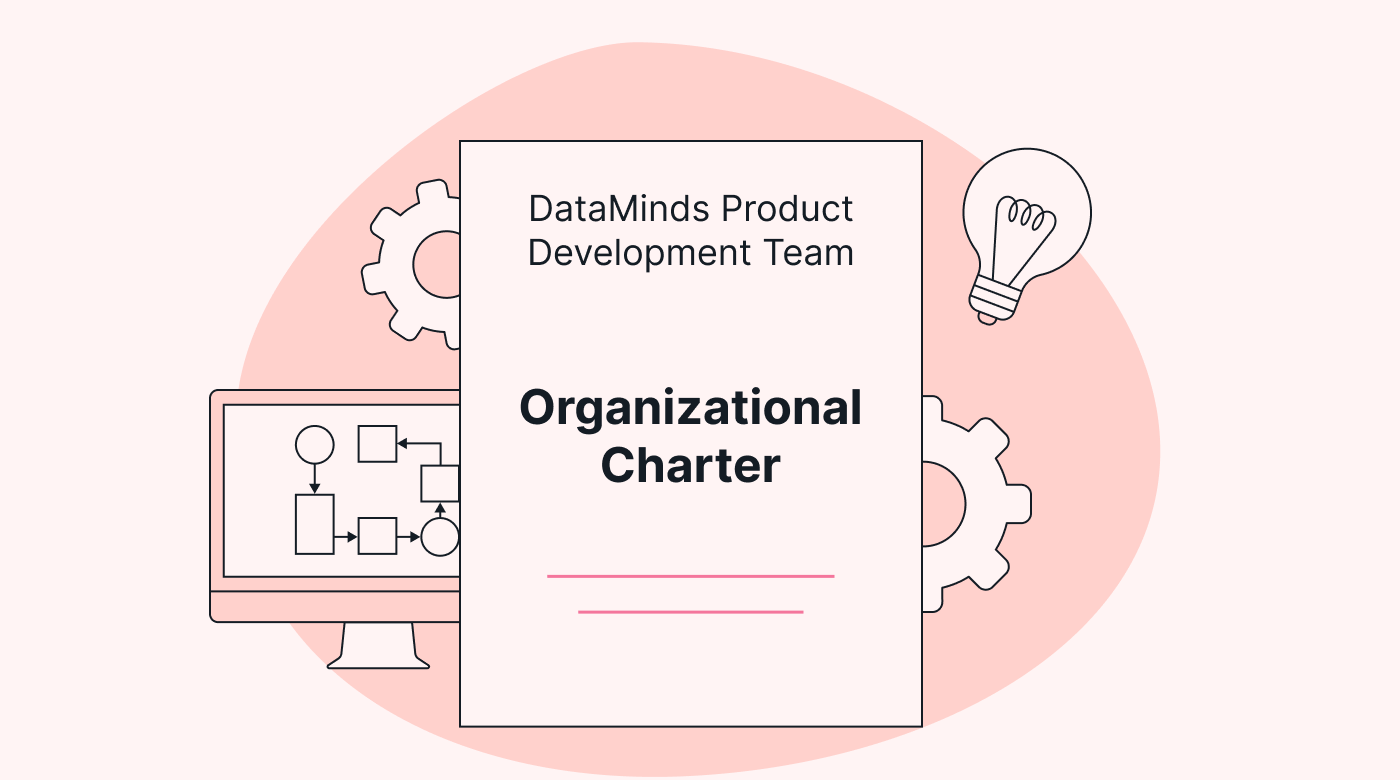 |
DataMinds Product Development Team
Team Charter
Team purpose
The DataMinds Product Development Team is responsible for conceptualizing, designing, and implementing new features and updates to our cloud-based marketing analytics platform. Our goal is to provide clients with cutting-edge tools that will empower them to make data-informed decisions and achieve their marketing objectives.
Team members and roles
- Product Development Manager: Oversees the team, sets the strategic direction for product development, and ensures alignment with the company’s goals.
- Developers: Take charge of technical implementation, architecture design, and coding for new features and enhancements.
- UX/UI Designer: Designs the user experience and interface for new features; focuses on usability, clarity, and aesthetic appeal.
- Quality Assurance Specialist: Conducts thorough testing and quality checks on all features before deployment for a seamless user experience.
- Data Analyst: Collaborates with the team to ensure that analytics and insights are accurately integrated into the platform’s new features.
- Project Coordinator: Manages project timelines, communication, and coordination among team members for an efficient workflow.
Team goals
- To introduce innovative features and functionalities that set our analytics platform apart in the market.
- To consistently meet project deadlines and deliver new features and enhancements on schedule.
- To prioritize a user-centric design approach, making sure that new features are intuitive and contribute positively to the user experience.
- To uphold the highest standards of quality and reliability through rigorous testing and quality checks.
- To nurture a collaborative and communicative environment within the team, characterized by open dialogue and idea sharing.
Team values and operating principles
- Clear communication
- Collaboration
- Accountability
- Innovation
- Adaptability
- Continuous feedback and improvement
Date of Charter Approval: [Insert Date]
Authorized By: [Product Development Manager’s Name]
Use your charter for effective project management
An organizational charter expresses a company’s mission, values, and goals, which are then translated into detailed business plans. Derivative team charters spell out the roles and responsibilities of each team and the individual team members.
Once the goals and objectives are clear, it’s helpful to use project management and time management software to align team projects with the company’s strategic direction and goals.
 |
Intelligent project management apps, such as Motion’s AI-driven Project Manager, are great tools for helping ensure the charter you’ve developed will be translated into targeted action.
To get started, try Motion for free for seven days.





